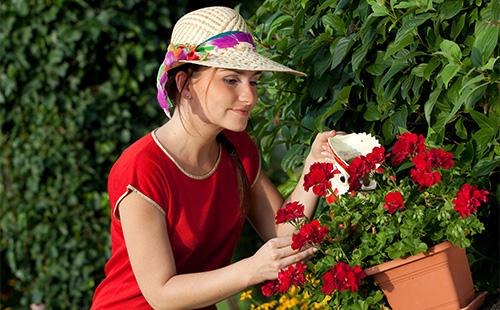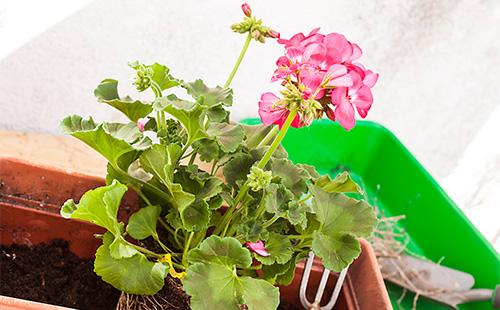The content of the article
Another name for the flower is ivy geranium. With good care, it forms strong flowing shoots with a length of 50 cm to 1 m. Another feature is smooth five-fingered leaves without pubescence. The color of the leaves is monophonic and colorful.
Description and difference from ordinary geranium
Growing ampelous geraniums at home does not cause much trouble - the flower easily adapts to the microclimate of the apartment. In summer he prefers fresh air - hanging pots can be taken out to the balcony or hung in the garden. Coloring of flowers is various. Varieties with white, red, lilac, orange, pink, flowers are often found. Inflorescences are lush, in appearance resemble a pompom.
The length of the drooping stems reaches 90 cm. The leaves are smooth with the original five-fingered shape. A feature of ampelous geraniums is a long flowering period. It begins at the very beginning of spring, ends near the end of autumn. Throughout the flowering period, wilted flowers are removed.
Ampelic differs from ordinary geranium both in appearance and care features. The main difference between ampel geraniums from ordinary.
- The stalks. Thin, hanging down to a meter long. Ordinary geraniums have short, erect stems.
- Shoots. Many thinner, more flexible shoots depart from the main stem. The bush looks voluminous, lush.
- Leaves. Ordinary geranium leaves are rounded, pubescent, soft. In ampelous - smooth, with a glossy sheen.
- The buds. Inflorescences are larger and brighter.
How to choose a flower in the store and take care after purchase
Pay attention to instances with buds, not blooming flowers. Assess the condition of the plant. Spots on leaves and stems, lethargy, bare bottom of shoots - all this indicates that the flower is sick or does not receive the necessary care. How to care for ampel geraniums after purchase?
- Quarantine. For two weeks, geraniums are set separately from the rest of the flowers. The initial signs of illness or pests in the store could go unnoticed. During this period, they will certainly prove themselves. Quarantine is necessary not only to facilitate adaptation, but also to protect other colors from infection.
- Watering and feeding. At first, curly geranium should receive a moderate amount of moisture. Feeding is not necessary. Fertilizing facilitates adaptation, but leads to weakening of the plant in the future.
- Lighting. The purchased plant is placed in a well-lit, but protected from direct sunlight place. It is recommended not to put it on the windowsill, but on the bedside table or table next to the window. After a period of adaptation, one is accustomed to brighter lighting gradually.
- Transfer. If the soil condition is satisfactory, there is no need to rush with a transplant.Excess stress will lead to weakening of the plant, making it difficult to adapt. It is better to transplant in about three weeks, when the flower takes root in a new place. If geranium was purchased in the fall or winter, it is better to postpone the transplant in the spring.
Caring for ampel geraniums after transplantation is gentle. The transplanted plant is kept in a warm place, shaded from the sun, watered regularly, but in moderation. The roots have not yet taken root - plentiful watering will lead to their decay. Top dressing is stopped for two months - in fresh soil there are enough nutrients.
Care for ampel geraniums: basic recommendations
Ampel geranium is more capricious compared to ordinary, but difficulties in growing are rare. The flower responds gratefully to the creation of a favorable climate, regular watering, periodic top dressing. A number of rules are taken as the basis for leaving.
- Lighting. Lack of light leads to a decrease in decorativeness, loss of splendor, weak flowering. Try to place next to the south, east and west windows. They hide from the sun - the leaves easily get burns.
- Temperature. The plant is thermophilic, but reacts sharply to heat. Favorable temperature for full growth and flowering 20–25 ˚С. In winter, keep cool - about 15˚С.
- Watering. Watering is regular, moderate. Waterlogging is undesirable. Light drought, temporary cessation of watering tolerates easier than damp. Sudden changes in soil moisture are undesirable. In winter, they focus on soil moisture - it should dry out by a third.
- Air humidity. They grow better in low humidity. Dry air favors plant health. Spraying geraniums does not like. The accumulation of drops of water in the axils of the leaves is fraught with rotting.
- Priming. A good soil composition is a mixture of deciduous humus, sand and peat. The main requirements for the soil are lightness, friability. In too nutritious soils, geranium does not bloom, but actively grows new shoots and leaves.
- Top dressing. Ampelny geranium can quite do without top dressing. Periodic application of small doses of fertilizers has a positive effect on its growth. Drugs containing nitrogen are avoided - they stimulate rapid growth, inhibit the laying of flower buds. It is better to feed ampel geranium with phosphorus and potassium fertilizer. They are applied with watering only on moist soil, the concentration is halved.
- Rest period. In winter, geranium slows growth, rests, prepares for the next flowering. Favorable conditions - temperature not lower than 11 ° C and not higher than 15 ° C, moderate watering. Without a dormant period, geraniums may not bloom.
- Transfer. Transshipment is done every two years. Geranium is removed from the pot without destroying the lump of earth, placed in a new container, add fresh soil. The root system is poorly developed - a small pot is taken. In a spacious pot, flowering will be weak.
How and when to crop
Cutting ampel geranium stimulates the growth of side shoots, maintains the neat shape of the bush, rejuvenates the plant, promotes abundant flowering. Without pruning, the decorativeness of geraniums quickly decreases, the bush looks disheveled, blooms worse.
Pruning is carried out at the beginning of the rest period - in the fall. Very lush plants require more energy to recover - the next flowering may form weak inflorescences.During autumn pruning, the main shoots are shortened to seven leaves, the side shoots are cut. Young lashes coming from the root do not touch.
If during the winter the geranium managed to grow, in the spring pruning is repeated. Remove excess, weak stems. Ampel geraniums continue to be pinched all spring, removing the tops of new shoots after the fifth leaf. A regular, neat crown forms a lush, neat crown.

Methods and rules of reproduction
Ampel geranium is propagated in two ways - by seeds and cuttings. The second method is considered more effective - when grafting, the characteristics of the variety are fully preserved. Growing from seeds is laborious. Using seeds collected from your plant does not always give good results.
Seeds
Features For the cultivation of geraniums, it is better to use seeds purchased in specialized stores. This method is more suitable for obtaining a new variety, rather than propagating. Hybrid species are not commonly propagated by seed. Geraniums are sown in December, so that by spring the seedlings have already started growing. It is advisable to use artificial illumination at the stage of germination and the beginning of the development of sprouts.
Action algorithm
- A shallow wide container is filled with a soil mixture consisting of sand, peat, sphagnum and garden soil.
- Seeds are laid out on the surface at a short distance from each other. Sprinkle with a layer of soil up to 5 mm.
- The soil is moistened, the container is covered with a film. They put in a warm place under fluorescent lamps.
Cuttings
Features Propagating geranium geraniums by cuttings is simple. They take root easily, quickly grow. Cutting time is combined with autumn or spring pruning. The tops of the shoots are used as planting material.
Action algorithm
- Cuttings are cut with a length of not more than 12 cm. The lower leaves are removed.
- The cuttings are dried for two hours, dipped in coal powder and planted directly in light soil with peat and sphagnum content. Geranium cuttings often rot in water.
- Keep warm, in the light, under a cap from the cut-off plastic cylinder. Moisturize the soil regularly, avoid getting water on the stem.
- After the appearance of signs of growth, the main stem is pinched to stimulate lateral branching.
If it is not possible to root the ampelian geranium, before planting, treat the cuttings with the root stimulator “Kornevin”, “Heteroauxin”. The roots will appear much faster.

Growing problems
Despite the unpretentiousness of geraniums, pests can attack it. Fungal and viral diseases are not excluded. Most of the problems are due to improper care. The most common problems and their causes are shown in the table.
Table - The main problems in growing ampelous geraniums
| Problem | Possible reasons | ||
|---|---|---|---|
| Errors of care | Insects | Disease | |
| Leaves turn yellow | - Waterlogging; - excess sun; - cramped pot; - drafts; - dry soil | - Whitefly; - aphids | - Rot |
| Gray-brown spots appear, there is no flowering, the foliage dries | - spraying; - waterlogging of the soil; - unventilated room; - excess nitrogen | - Not typical for pests | - Gray rot |
| Gray-brown spots with a bright center appear, there is a velvety coating, the leaves dry out | - Dense soil; - poor ventilation; - excessive watering | - Not typical for pests | - Alternariosis |
| Dark depressed spots appear, the plant fades | - heat; - excess moisture; - poor ventilation; - excess fertilizer; - lack of light | - Not typical for pests | - Rhizoctonia rot |
| The plant turns yellow, blackens, lower leaves fade | - Poor soil; - lack of pruning; - drying of soil | - Not typical for pests | - Verticillin wilt |
| Clear yellow spots appear, brown growths, the plant fades | - Waterlogging of the soil; - heat | - Not typical for pests | - rust |
| The plant withers, the stems decay, indented spots appear on the roots | - bush density; - poor ventilation; - dampness; - lack of light; - excess fertilizer; - bad soil | - Not typical for pests | - late blight |
| Roots rot, growth stops, geranium dies | - Poor lighting; - bush density; - heat; - poor-quality soil; - excess nitrogen | - Not typical for pests | - root rot |
| Leaves turn yellow and curl. | - dry air; - dry soil | - Aphids | - Not typical for diseases |
| Growth stops, upper leaves coarse | - Wet air; - heat | - Multi-claw ticks | - Not typical for diseases |
| Red spots appear on the leaves | - cold; - lack of nutrients | - Not typical for pests | - Fungal diseases |
| Leaf edges dry | - lack of moisture; –Excess of the sun; - root problems | - Aphids; - thrips; - shield | - Fungus; - rust |
How to care for ampelous geraniums during a period of illness? It is necessary to eliminate the errors of care, to create the most favorable conditions. Features of the content in this period are determined by the condition of the plant, the main cause of the disease.
Ampel geranium is a spectacular plant that perfectly complements any interior. Care for it is minimal, flowering is long and beautiful. Due to the long hanging lashes, geranium looks decorative not only in summer but also in winter.

